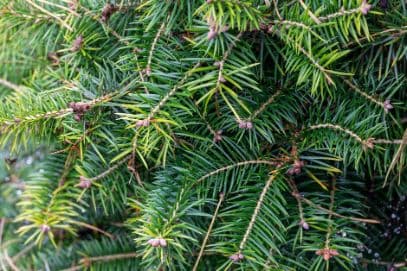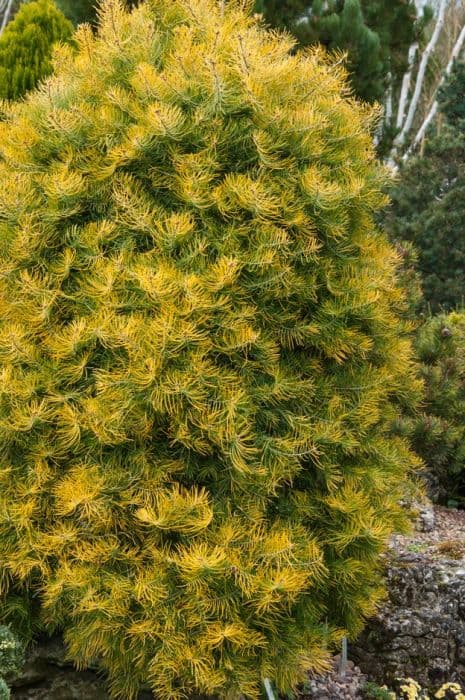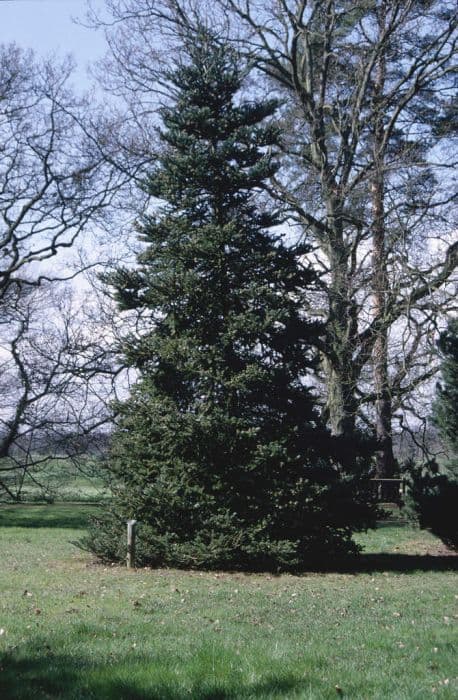Dwarf Blue Himalayan Pine Pinus wallichiana 'Nana'

ABOUT
Pinus wallichiana 'Nana' is a dwarf conifer commonly known as Dwarf Himalayan Pine. It features a compact growth habit, with branches that often grow densely. The needles of this pine are long, thin, and flexible, typically arranged in bundles of five. These needles possess a bluish-green color that brings a unique texture and tone to the plant's overall appearance throughout the year. The Dwarf Himalayan Pine produces cones which are initially slender and purplish but mature to a brown hue over time, adding decorative interest to the plant. The bark of the tree is rough and deeply furrowed, often displaying a greyish-brown color that contrasts nicely with the blue-green needles. This variety of pine is typically desired for its ornamental qualities, as it adds vertical interest to garden landscapes without occupying a large footprint. Its distinctive needle color and compact form make it a visually appealing addition to rock gardens, small yards, or as a specimen in mixed conifer arrangements.
About this plant
 Names
NamesFamily
Pinaceae.
Synonyms
Dwarf Bhutan Pine, Dwarf Blue Pine, Dwarf Himalayan Pine, Miniature Himalayan Pine.
Common names
Pinus griffithii 'Nana', Pinus excelsa 'Nana'.
 Toxicity
ToxicityTo humans
Himalayan pine is not known to be toxic to humans. However, ingesting any part of the plant is not recommended and if concerns arise, medical advice should be sought.
To pets
Himalayan pine is generally not toxic to pets; however, ingestion, especially of needles or sap, can sometimes cause mild gastrointestinal upset such as vomiting or diarrhea. If your pet displays symptoms after ingesting any part of the plant, consult a veterinarian.
 Characteristics
CharacteristicsLife cycle
Perennials
Foliage type
Evergreen
Color of leaves
Green
Height
4-6 feet (1.2-1.8 meters)
Spread
4-6 feet (1.2-1.8 meters)
Plant type
Tree
Hardiness zones
5-7
Native area
Himalayas
Benefits
 General Benefits
General Benefits- Compact Size: 'Nana' is a dwarf cultivar, making it suitable for smaller gardens or spaces where a full-sized Himalayan pine would be too large.
- Ornamental Appeal: The plant has a distinctive growth pattern and attractive blue-green needles that offer year-round visual interest.
- Low Maintenance: Requires minimal pruning and care once established, which can be ideal for busy gardeners or those looking for ease of upkeep.
- Cold Hardy: Himalayan pine 'Nana' is tolerant of cold temperatures, which makes it suitable for planting in a variety of climates.
- Soil Adaptability: Adapts to a range of soil types, although it prefers well-drained conditions.
- Erosion Control: The root system can help stabilize slopes and prevent soil erosion.
- Wildlife Habitat: Provides shelter and food for birds and other wildlife, adding to the biodiversity of the garden ecosystem.
- Resilience: Shows good resistance to pests and diseases, reducing the need for chemical treatments.
- Longevity: Pines are known for their long lifespan, which ensures that the plant will be a lasting addition to the landscape.
 Medical Properties
Medical PropertiesThis plant is not used for medical purposes.
 Air-purifying Qualities
Air-purifying QualitiesThis plant is not specifically known for air purifying qualities.
 Other Uses
Other Uses- Crafting Bonsai: Pinus wallichiana 'Nana', also known as Dwarf Himalayan Pine, is ideal for bonsai due to its naturally miniature size and aesthetic form, allowing enthusiasts to create and maintain miniature landscapes.
- Photography: Its unique form and texture make the Dwarf Himalayan Pine a favorite subject for photographers, especially in snowscapes where its structure stands out.
- Education: Horticultural programs often use Dwarf Himalayan Pine to teach techniques in pruning, grafting, and caring for coniferous plants.
- Model Landscaping: The tree can be used in creating realistic models or dioramas for architectural presentations and hobbyist model landscapes due to its scaled-down size.
- Therapeutic Horticulture: The nurturing and maintenance of this pine are used as a therapeutic activity to improve mental health and well-being, stressing the calming effects of gardening.
- Culinary Presentation: Its small branches and needles can be used as a natural decor in gourmet dishes, although the parts are not eaten themselves.
- Seasonal Decorations: During festive seasons, the Dwarf Himalayan Pine can be used as a living Christmas decoration that aligns with sustainable practices.
- Climatic Studies: As an alpine species, it is sometimes used in climatic studies to understand the impact of temperature changes in mountain ecosystems.
- Wildlife Habitat Creation: Although small, the tree can provide shelter or nesting spots for certain small birds and insects when planted in groups.
- Art Supplies: The tree's natural resin can be collected and processed to be used in traditional painting techniques.
Interesting Facts
 Feng Shui
Feng ShuiThe Dwarf Himalayan Pine is not used in Feng Shui practice.
 Zodiac Sign Compitability
Zodiac Sign CompitabilityThe Dwarf Himalayan Pine is not used in astrology practice.
 Plant Symbolism
Plant Symbolism- Longevity: Pinus wallichiana 'Nana', commonly known as Dwarf Blue Himalayan Pine, is a pine species that can live for many years. Its longevity lends it the symbolic meaning of enduring life and timelessness.
- Resilience: As a pine species adept at surviving in harsh conditions, the Dwarf Blue Himalayan Pine represents resilience and the ability to withstand challenges.
- Peace: Pine trees are often associated with tranquillity and peace. Their evergreen nature and the soft whisper of the wind through the needles bring a sense of calm, which the Dwarf Blue Himalayan Pine exemplifies.
- Wisdom: In many cultures, pine trees symbolize wisdom due to their long lifespans and enduring presence. The Dwarf Blue Himalayan Pine, as a variation, also carries this symbolic meaning.
- Fertility: Pine cones, produced by pine trees like the Dwarf Blue Himalayan Pine, have traditionally symbolized fertility and regeneration.
 Water
WaterThe Dwarf Himalayan Pine prefers watering that allows the soil to dry out slightly between sessions. It should be watered every 7 to 10 days, with increased frequency during hot, dry periods. Provide deep watering to saturate the root zone, using around 2 gallons per watering for a mature plant, ensuring you decrease frequency as the weather cools. Consistent watering is crucial during the first growing season to establish a deep, extensive root system. Overwatering can lead to root rot, so ensure proper drainage.
 Light
LightThe Dwarf Himalayan Pine thrives in full sun exposure. It requires at least 6 hours of direct, unfiltered sunlight each day. The best spot for this pine is an open area where it is not overshadowed by larger trees or buildings, as sufficient light is essential for healthy growth and needle development.
 Temperature
TemperatureThe Dwarf Himalayan Pine is a hardy plant that can tolerate a wide range of temperatures, from winter lows around -20 degrees Fahrenheit to summer highs well into the 80s or 90s. The ideal temperature range for optimal growth is between 60 and 70 degrees Fahrenheit. Its tolerance to cold makes it suitable for many temperate regions without concern for winter damage.
 Pruning
PruningPruning the Dwarf Himalayan Pine is typically done to shape the plant or remove damaged or diseased branches. Prune in late winter or early spring before new growth starts. It is not necessary to prune every year; simply do so as needed to maintain the desired shape or size. Avoid heavy pruning, as pines do not readily regrow from old wood.
 Cleaning
CleaningNot needed
 Soil
SoilThe best soil mix for Himalayan Pine (Pinus wallichiana 'Nana') is well-draining with a mix of loam, sand, and organic matter like pine bark. The soil pH should be slightly acidic to neutral, between 5.5 and 7.0.
 Repotting
RepottingHimalayan Pine should be repotted every 2-3 years to refresh the soil and accommodate root growth. For mature specimens, repotting may be needed less frequently if top-dressing with fresh soil is done.
 Humidity & Misting
Humidity & MistingHimalayan Pine thrives in moderate humidity levels but is quite adaptable to lower humidity. It does not require high humidity environments to thrive.
 Suitable locations
Suitable locationsIndoor
Provide bright light, cool temperatures, and good airflow.
Outdoor
Plant in well-draining soil, full sun, and protect from strong winds.
Hardiness zone
5-7 USDA
 Life cycle
Life cyclePinus wallichiana 'Nana', commonly known as Dwarf Bhutan Pine, begins its life cycle as a seed, typically requiring a period of cold stratification to break dormancy. Upon germination, it develops into a seedling, exhibiting characteristic needle-like leaves. As it matures, it enters a vegetative stage where it establishes a robust root system and a woody stem, gradually growing into a compact dwarf form. During the reproductive stage, which can take years to commence, it produces cones; male cones release pollen which is carried by wind to female cones for fertilization. Once fertilized, the female cones develop seeds over a period, eventually maturing and releasing them to start a new generation. The Dwarf Bhutan Pine is relatively slow-growing and can live for many decades, with some individuals persisting for over a century.
 Propogation
PropogationPropogation time
Spring-Early Summer
The most popular method for propagating Pinus wallichiana 'Nana', commonly known as Dwarf Himalayan Pine, is through seed sowing. Seeds should ideally be sown in late winter to early spring, as cold stratification is needed to break the seed dormancy. This can be done by placing seeds in a sealed bag with moist sand or peat moss and refrigerating them at approximately 34 to 41 degrees Fahrenheit (1 to 5 degrees Celsius) for about 4 to 6 weeks. After stratification, seeds are sown in well-draining soil in a cold frame or unheated greenhouse. Covering the seeds lightly with soil helps to prevent them from drying out. Consistent moisture should be maintained, but overwatering should be avoided to prevent rot. Germination can take several weeks to months, and patience is essential with this process.









